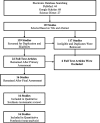Prevalence, types and determinants of anemia among pregnant women in Sudan: a systematic review and meta-analysis
- PMID: 30455961
- PMCID: PMC6225563
- DOI: 10.1186/s12878-018-0124-1
Prevalence, types and determinants of anemia among pregnant women in Sudan: a systematic review and meta-analysis
Abstract
Background: Anemia during pregnancy is a public health problem especially in developing countries and it is associated with maternal and perinatal adverse outcomes. There is no meta-analysis on anemia during pregnancy in Sudan. The current systemic review and meta-analysis was conducted to assess the prevalence, types and determinant of anemia during pregnancy in Sudan.
Methods: Preferred Reporting Items for Systematic Reviews and Meta-Analyses (PRISMA) guideline was followed. The databases (PubMed, Cochrane Library, Google Scholar, CINAHL, and African Journals Online) were searched using; anemia, pregnancy related anemia and Sudan. Joanna Briggs Institute Meta-Analysis of Statistics Assessment and Review Instrument (JBI-MAStARI) and Modified Newcastle - Ottawa quality assessment scale were used for critical appraisal of studies. The pooled Meta logistic regression was computed using OpenMeta Analyst software.
Results: Sixteen cross-sectional studies included a total of 15, 688 pregnant women were analyzed. The pooled prevalence of anemia among pregnant women in Sudan was 53.0% (95%, CI = 45.9-60.1). The meta-analysis showed no statistical significant between the age (mean difference = 0.143, 95 CI = - 0.033 - 0.319, P = 0.112), parity (mean difference = 0.021, 95% CI = - 0.035 - 0.077, P = 0.465) between the anemic and no anemic women. Malaria was investigated in six studies. Pregnant women who had malaria infection during pregnancy were 1.94 times more likely to develop anemia than women who had no malaria infection (OR = 1.94, 95% CI =1.33-2.82). Six (37.5%) studies investigated type of anemia. The pooled prevalence of iron deficiency anemia (IDA) among pregnant women in Sudan was 13.6% (95% CI = 8.9-18.2).
Conclusion: There is a high prevalence of anemia among pregnant in the different region of Sudan. While age and parity have no association with anemia, malaria infection was associated with anemia. Interventions to promote the strengthening of antenatal care, and access and adherence to nutrition, and malaria preventive measures are needed to reduce the high level of anemia among pregnant women in Sudan.
Keywords: Age; Anemia during pregnancy; Malaria during pregnancy; Meta-analysis, systematic review; Parity; Prevalence of anemia; Sudan.
Conflict of interest statement
Not applicable.Not applicable.The authors declare that they have no competing interests.Springer Nature remains neutral with regard to jurisdictional claims in published maps and institutional affiliations.
Figures






Similar articles
-
Prevalence and determinants of anemia among pregnant women in Ethiopia; a systematic review and meta-analysis.BMC Hematol. 2017 Oct 17;17:17. doi: 10.1186/s12878-017-0090-z. eCollection 2017. BMC Hematol. 2017. PMID: 29075500 Free PMC article.
-
The Prevalence of Malaria among Pregnant Women in Ethiopia: A Systematic Review and Meta-Analysis.J Parasitol Res. 2019 May 2;2019:8396091. doi: 10.1155/2019/8396091. eCollection 2019. J Parasitol Res. 2019. PMID: 31186950 Free PMC article. Review.
-
Prevalence and determinants of Anemia among pregnant women in sub-Saharan Africa: a systematic review and Meta-analysis.Arch Public Health. 2021 Dec 3;79(1):219. doi: 10.1186/s13690-021-00711-3. Arch Public Health. 2021. PMID: 34861892 Free PMC article. Review.
-
Compliance with Iron and Folic Acid Supplementation (IFAS) and associated factors among pregnant women in Sub-Saharan Africa: A systematic review and meta-analysis.PLoS One. 2021 Apr 14;16(4):e0249789. doi: 10.1371/journal.pone.0249789. eCollection 2021. PLoS One. 2021. PMID: 33852614 Free PMC article.
-
Prevalence of schistosomiasis and its association with anemia among pregnant women: a systematic review and meta-analysis.Parasit Vectors. 2021 Mar 2;14(1):133. doi: 10.1186/s13071-021-04642-4. Parasit Vectors. 2021. PMID: 33653391 Free PMC article.
Cited by
-
Prevalence of Anemia and Associated Factors among Pregnant Women in Kigeme Refugee Camp, Rwanda.Rwanda J Med Health Sci. 2024 Jul 31;7(2):239-247. doi: 10.4314/rjmhs.v7i2.12. eCollection 2024 Jul. Rwanda J Med Health Sci. 2024. PMID: 40567841 Free PMC article.
-
The Prevalence of Anemia among Pregnant Women in China: A Systematic Review and Meta-Analysis.Nutrients. 2024 Jun 13;16(12):1854. doi: 10.3390/nu16121854. Nutrients. 2024. PMID: 38931209 Free PMC article.
-
Adverse Pregnancy Outcomes in Sickle Cell Trait: a Prospective Cohort Study Evaluating Clinical and Haematological Parameters in Postpartum Mothers and Newborns.Mediterr J Hematol Infect Dis. 2023 Jan 1;15(1):e2023002. doi: 10.4084/MJHID.2023.002. eCollection 2023. Mediterr J Hematol Infect Dis. 2023. PMID: 36660349 Free PMC article.
-
Prevalence and determinants of anemia among pregnant women in East Africa; A multi-level analysis of recent Demographic and Health Surveys.PLoS One. 2021 Apr 27;16(4):e0250560. doi: 10.1371/journal.pone.0250560. eCollection 2021. PLoS One. 2021. PMID: 33905448 Free PMC article.
-
Anemia in pregnancy: a systematic review and meta-analysis of prevalence, determinants, and health impacts in Egypt.BMC Pregnancy Childbirth. 2025 Jan 14;25(1):29. doi: 10.1186/s12884-024-07111-9. BMC Pregnancy Childbirth. 2025. PMID: 39810098 Free PMC article.
References
-
- Worldwide prevalence of anaemia. 1993. http://apps.who.int/iris/bitstream/10665/43894/1/9789241596657_eng.pdf. Accessed 21 Feb 2018.
LinkOut - more resources
Full Text Sources

